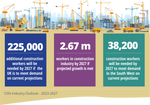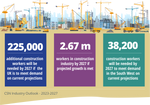What is hindering your market at the moment?
The time taken to get deals done. It seems to be taking far longer for occupiers to make decisions about committing to a new project, such as relocating or securing a new facility. There has definitely been an uptick in the number of active requirements from occupiers since the beginning of the year, however, there is now more technical and financial due diligence earlier on in the process. This causes delays between the initial viewing stage and engagement about terms.
Whilst there is still some uncertainty in the market, and therefore we appreciate that companies need to get approval before committing to relocation expenses, we anticipate that once there’s some economic stability, the pace of decision-making will accelerate. We are expecting this shift to be later in 2024– particularly when supply begins to tighten.
What opportunities are you seeing in your market at the moment?
I feel like a slightly broken record, but the much-anticipated opening of Junction 1 on the M49 will significantly improve access to Severnside. This “ghost junction” has been promised for almost a decade, attracting major occupiers to Avonmouth, including Amazon, LIDL, The Range and DHL. As a result, it has already become an established distribution hub and is considered the gateway to the South West and South Wales. However, the delayed opening of the junction has likely hindered rental growth compared to other regional distribution centres.
The junction is expected to open in summer 2025 once the local authority completes the link road, and we’re confident that Severnside will become a significant growth market.
What’s the biggest change you have seen in your sector throughout your career?
The scale of industrial and warehouse buildings has grown dramatically over the past decade. When I first started in the industry around 12 years ago, a 100,000 sq ft warehouse was considered large. Whereas we’re now more frequently dealing with units in excess of 300,000 sq ft and we’ve been involved in handling several transactions over 1,000,000 sq ft over the last few years – the most notable being the 2,200,000 sq ft Amazon depot in Swindon, where we acted for Panattoni.
This growth is driven by the rise in online consumer spending and the pursuit of efficiency by third-party logistics providers and retailers. Consolidation enables the processing of a larger volume of products, whether for a single retailer or within a multi-user facility.
Looking further afield across Europe, XXL warehouses (over 500,000 sq ft) now account for around a quarter of the total take-up compared to approximately 10% a decade ago. With the help of advanced technology, warehouses are now able to handle larger volumes of goods, reduce errors, and improve overall customer satisfaction. It’ll be fascinating to see how warehouse sizes evolve by 2035 after another decade of advancements in the logistics sector!
What are your predictions for the next 12-18 months, in your sector?
In the first half of this year, the market was weighted in favour of tenants, allowing them to secure more competitive terms, including lower rents and rent-free periods for existing spaces. This shift was a direct result of the slower market during 2023, which led to landlords experiencing a longer void period than they had budgeted for, and delayed decision-making by occupiers. Consequently, supply remained high, and no speculative developments were initiated last year.
However, some deals are starting to materialise, and the existing space will finally be absorbed. If these deals eventually complete, the supply and demand dynamic will quickly flip in favour of landlords, leaving occupiers with fewer options to consider for immediate occupation. This shift will put upward pressure on rents, leading to anticipated rental growth towards the end of the year and a reduction in incentives offered.
What has been the best piece of advice that you’ve been given during your career?
I have been given two pieces of key advice:
1. “You make your own luck” – effectively the more proactive and efficient you are with your time, the more fortunate you will become, and luck will fall in your favour.
2. “Never burn a bridge and always be graceful in defeat, it’ll come around to benefit you in the long run” – a client from the US once shared a story where they put their country-wide agency mandate out to tender. One particular property agency firm was confident that they were guaranteed the appointment due to an existing relationship with the client. However, the mandate ended up being awarded to another company. The overly confident agency reacted poorly, damaging their relationship with the client.
It later emerged that the successful agency firm had a conflict that they could not manage, so had to turn down the work. If the bridge hadn’t been burnt with the runner up, they would have secured a guaranteed instruction. Instead, their behaviour led the client to exclude them from future considerations, ultimately awarding the mandate to another agency. The moral is clear: the market is too small, and reputations matter. What goes around comes around, and no instruction is guaranteed until terms are signed.

























